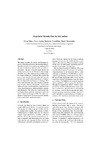Please use this identifier to cite or link to this item:
https://accedacris.ulpgc.es/jspui/handle/10553/1311
| DC Field | Value | Language |
|---|---|---|
| dc.contributor.author | Déniz Suárez, Oscar | en_US |
| dc.contributor.author | Antón Canalís, Luis | en_US |
| dc.contributor.author | Castrillón-Santana, Modesto | en_US |
| dc.contributor.author | Hernández Tejera, Francisco Mario | en_US |
| dc.date.accessioned | 2009-10-08T02:31:00Z | - |
| dc.date.accessioned | 2018-03-01T13:33:58Z | - |
| dc.date.available | 2018-03-01T13:33:58Z | - |
| dc.date.issued | 2006 | en_US |
| dc.identifier.other | 2034 | - |
| dc.identifier.uri | https://accedacris.ulpgc.es/handle/10553/1311 | - |
| dc.description.abstract | This paper describes the current development status of a robot head with basic interactional abilities. On a theoretical level we propose an explanation for the lack of robustness implicit in the so-called social\nrobots. The fact is that our social abilities are mainly unconscious to us. This lack of knowledge about the form of the solution to these abilities leads to a fragile behaviour. Therefore, the engineering point of view must be seriously taken into account, and not only insights taken from human disciplines like developmental psychology or ethology. Our robot, built upon this idea, does not have a definite task, except to interact with people. Its perceptual abilities include sound localization, omnidirectional vision, face detection, an attention module, memory and habituation. The robot has facial features that can display basic emotional expressions, and it can speak canned text through a TTS. The robot’s behavior is controlled by an action selection module, reflexes and a basic emotional module. | en_US |
| dc.language | eng | en_US |
| dc.source | VII Workshop de Agentes Físicos. Ponencia oral | en_US |
| dc.subject | 120304 Inteligencia artificial | en_US |
| dc.subject.other | Robótica | en_US |
| dc.title | Expressive robotic face for interaction | en_US |
| dc.type | info:eu-repo/semantics/article | en_US |
| dc.type | Article | en_US |
| dc.identifier.absysnet | 533594 | - |
| dc.identifier.absysnet | 534844 | - |
| dc.identifier.crisid | -;-;2806;1194 | - |
| dc.investigacion | Ingeniería y Arquitectura | en_US |
| dc.project.reference | PI2003/165;PI2003/160;TIN2004-07087 | - |
| dc.rights.accessrights | info:eu-repo/semantics/openAccess | es |
| dc.type2 | Artículo | en_US |
| dc.identifier.external | 2034 | - |
| dc.identifier.external | -;-;2806;1194 | - |
| dc.utils.revision | Sí | en_US |
| dc.identifier.supplement | -;-;2806;1194 | - |
| dc.identifier.supplement | -;-;2806;1194 | - |
| dc.identifier.ulpgc | Sí | en_US |
| dc.contributor.buulpgc | BU-INF | en_US |
| item.grantfulltext | open | - |
| item.fulltext | Con texto completo | - |
| crisitem.author.dept | GIR SIANI: Inteligencia Artificial, Robótica y Oceanografía Computacional | - |
| crisitem.author.dept | IU Sistemas Inteligentes y Aplicaciones Numéricas | - |
| crisitem.author.dept | Departamento de Informática y Sistemas | - |
| crisitem.author.dept | GIR SIANI: Inteligencia Artificial, Redes Neuronales, Aprendizaje Automático e Ingeniería de Datos | - |
| crisitem.author.dept | IU Sistemas Inteligentes y Aplicaciones Numéricas | - |
| crisitem.author.dept | Departamento de Informática y Sistemas | - |
| crisitem.author.orcid | 0000-0002-8673-2725 | - |
| crisitem.author.orcid | 0000-0001-9717-8048 | - |
| crisitem.author.parentorg | IU Sistemas Inteligentes y Aplicaciones Numéricas | - |
| crisitem.author.parentorg | IU Sistemas Inteligentes y Aplicaciones Numéricas | - |
| crisitem.author.fullName | Castrillón Santana, Modesto Fernando | - |
| crisitem.author.fullName | Hernández Tejera, Francisco Mario | - |
| Appears in Collections: | Artículos | |
Page view(s)
106
checked on May 17, 2025
Download(s)
90
checked on May 17, 2025
Google ScholarTM
Check
Share
Export metadata
Items in accedaCRIS are protected by copyright, with all rights reserved, unless otherwise indicated.
